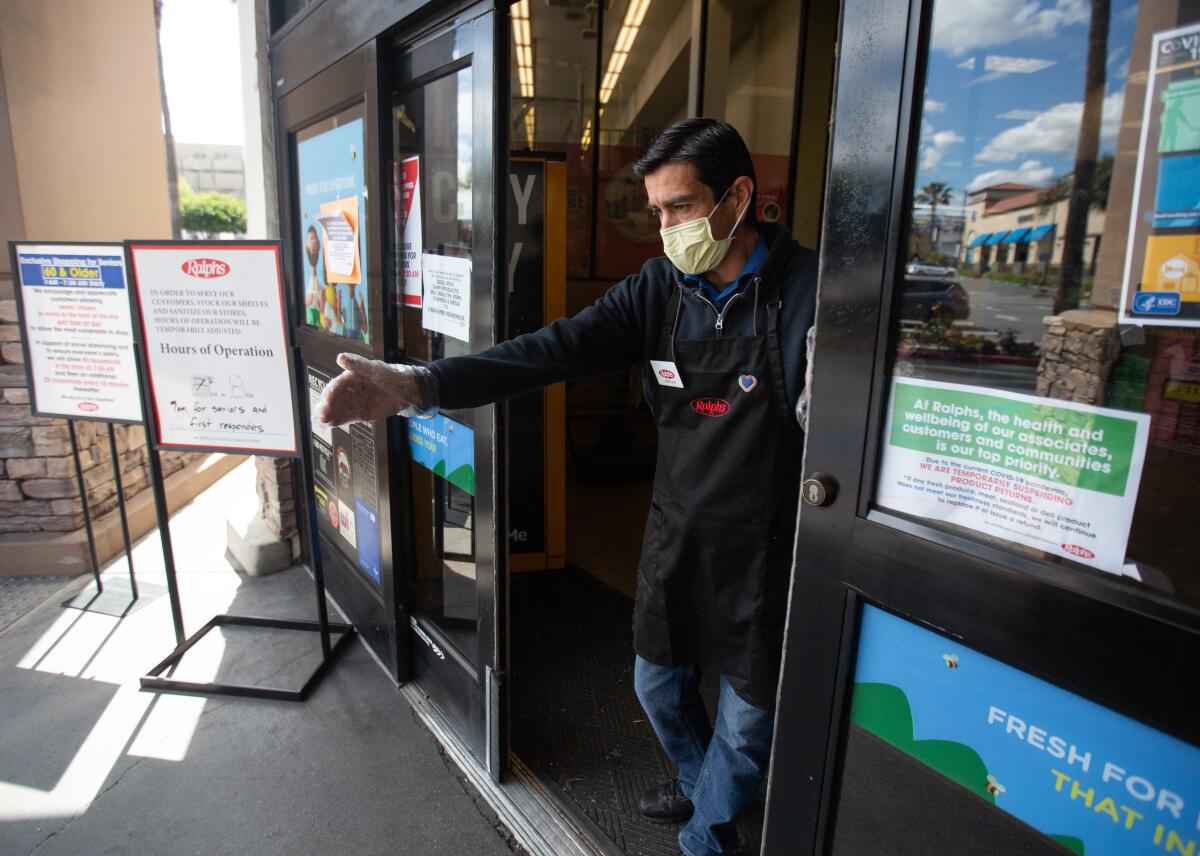2020 changed the way we live, work and spend. Here’s a look back

Good morning. I’m Rachel Schnalzer, the L.A. Times Business section’s audience engagement editor. Most weeks, The Times’ business newsletter is focused on the future — how individuals and small businesses can navigate the uncertainties of the pandemic and life in California.
But in this edition, our last of 2020, I’d like to look back.
Throughout the year, my colleagues and I have covered COVID-19’s devastating effects on people across California — small-business owners, Instacart drivers, Disneyland employees and more. We’ve kept a close eye on companies such as Tesla and Southern California Gas Co. And we’ve written about how life may change in 2021 and beyond. Here’s some of our best work.
Living and working in the pandemic
Remember the long checkout lines and toilet paper shortages at grocery stores early in the pandemic? During the second week of March, Times staff members scattered across Southern California’s grocery stores to chronicle the mayhem. “We’ve never sold out of pork butt before,” butcher John Casidsid told one Times journalist.
Beginning in the spring, our reporters examined how the pandemic changed our habits. Laurence Darmiento covered the explosion in charitable giving, and columnist David Lazarus asked an excellent question early in the shutdown of so many places of work and leisure: “Why isn’t car insurance cheaper as we all stay home?”
As it became clear the virus wasn’t going away quickly, our reporters covered how businesses were faring across Southern California. Experts expected a “tsunami” of hotel closures, Hugo Martín reported, and laid-off Disneyland employees struggled to make ends meet while mourning their lost jobs.
Some businesses reaped unexpected rewards. Daniel Miller described how RV and camper companies and drive-in movie theaters experienced a surge in popularity this year. And some entrepreneurs have shown remarkable creativity. Ronald D. White spoke extensively with workers and small-business owners who were forced to adapt this year.
Even during the pandemic, the extremely rich have largely managed to, well, continue being extremely rich. Jack Flemming explained how some wealthy people counted on bunkers to keep safe from the virus and others kept snapping up luxury homes.
But often, reporting on COVID-19 meant covering bleak situations.
Margot Roosevelt published a heartbreaking profile of Raquel Lezama, a hotel housekeeper who spent 20 years clawing out of poverty — only to face the possibility now of losing it all.
Many of the state’s most vulnerable workers will never see the end of the pandemic. Sam Dean covered the story of Amazon warehouse worker Harry Sentoso, one of the hundreds of thousands hired by the tech giant this year. Two weeks after starting work, he was dead from the virus. A similar thing happened to Uber driver Khaled Zayyid. Suhauna Hussain reported on how Proposition 22 held sway over whether Zayyid’s family — left without a breadwinner — would receive death benefits from the state.
Johana Bhuiyan tenaciously covered the realities of work as an Instacart shopper during the pandemic. The grocery delivery service’s shoppers and drivers told her they risk their health and work longer hours than ever before, with little to show for it.
Rights and fairness
As issues of justice and equity roiled our cities, The Times took a hard look at how Black and Latino people are still kept out of the tech industry. Johana Bhuiyan, Suhauna Hussain and Sam Dean spoke with tech workers of color who shared their experiences of racism on the job.
Issues of race also emerged in our climate and energy coverage. Sammy Roth reported on how the fossil fuel industry is attempting to cast itself as an ally of communities of color — even as those fuels kindle a global crisis that disproportionately harms people who aren’t white. (He also started Boiling Point, a climate and environment newsletter.)
Meanwhile, Russ Mitchell reported on the story of Cristina Balan, formerly an automotive engineer at Tesla’s Fremont plant. Her fight against the electric-vehicle maker may end up a milestone for employees’ rights.
Holding the government accountable
Geoffrey Mohan’s ambitious investigation into California’s Proposition 65 found that the sheer number of safety warnings has left consumers over-warned, under-informed and potentially unprotected.
Reporting by Melody Petersen — which revealed how body-part harvesting in morgues can upend death investigations — bore fruit: The L.A. County coroner said a company that procures body parts from the county morgue would begin preserving evidence.
Margot Roosevelt and columnist Michael Hiltzik explained how, under a proposed GOP relief plan, people wouldn’t be able to sue their employers over catching the coronavirus at work.
Local landmarks and beloved brands
Roger Vincent closely covered changes coming to L.A. landmarks, such as Hollywood & Highland and the waterfront where San Pedro’s Ports O’ Call once stood.
We also reported about the ways in which popular companies and brands such as Patagonia and Trader Joe’s have adjusted — or struggled to adjust — to the times (one created a provocative clothing tag that said “Vote the assholes out”; the other grappled with the consequences of branding its products with such names as “Trader Ming’s” and “Trader José’s”).
Oddities
Even during this painful year, quirky stories have popped up. For example, a feud between a bond king and his Laguna Beach neighbor, reported by Laurence Darmiento, drew a lot of attention — probably because the billionaire investor was accused of blaring the “Gilligan’s Island” theme song on loop to torment the neighbor.
When an airline pilot trying to land at Los Angeles International Airport said he’d just flown past a person in a jet pack, Samantha Masunaga explored whether that could possibly be true. (Separately, she also delved into who uses private helicopters in and around L.A.)
And as the field of presidential hopefuls narrowed, Suhauna Hussain got an inside look at some of the hundreds of ordinary people who were paid $2,500 each by Michael R. Bloomberg’s campaign to text their friends about the candidate and post about him on social media.
Looking toward the future
As we looked forward most of the year to 2020 finally ending, we strived to equip you with information to navigate current situations and insights into what’s coming next. Andrea Chang reported on how “work from anywhere” arrangements will change our workplaces, while Andrew Khouri reported on rising rents in L.A.’s suburbs.
My colleagues offered need-to-know information about the COVID-19 risk on airplanes and Gov. Gavin Newsom’s ban on sales of new gas-powered vehicles, which starts in 2035. We explained workers’ rights during the pandemic.
Hopefully, this newsletter helped too. If you have questions or suggestions for my editor and me, please let us know. Happy (almost) New Year. We’ll see you next week in 2021.
Consider subscribing to the Los Angeles Times
Your support helps us deliver the news that matters most. Become a subscriber.
Newer stories you may find helpful
◆ Stimulus checks are coming. Andrew Khouri explains who will get them, when, and how much money they will contain.
◆ Why aren’t more COVID-19 vaccine doses available immediately? Samantha Masunaga takes a look at vaccines’ production, distribution and storage issues.
◆ Tracking who gets vaccinated is vital for public health — but it’s raising privacy concerns. Melody Petersen describes the worries among those who help immigrant communities.
◆ No, California isn’t “hemorrhaging” people, columnist Michael Hiltzik writes. But, he says, the state “has no cause to be complacent about the future.”
◆ The housing market is red hot. Andrew Khouri spoke with experts to learn how long we can expect it to last.
◆ Hopefully you’re not planning to throw a rager on New Year’s Eve. But if you are, don’t try to book the party house on Airbnb. Andrea Chang explains what the platform is doing to discourage large gatherings over the holidays.
One more thing
To close out 2020, I’d like to share an enlightening, heartwarming story from aerospace reporter Samantha Masunaga.
For astronauts, life at the International Space Station can get pretty lonely. But talking to random people over ham radio helps. Masunaga spoke with astronauts and radio operators to learn how this channel of communication came to be, and how ham radios can ease the feelings of isolation felt by those in space. “It allowed me to ... just reach out to humanity down there,” NASA astronaut Doug Wheelock said. “It became my emotional, and a really visceral, connection to the planet.”
Have a question about work, business or finances during the COVID-19 pandemic, or tips for coping that you’d like to share? Send us an email at [email protected], and we may include it in a future newsletter.
Inside the business of entertainment
The Wide Shot brings you news, analysis and insights on everything from streaming wars to production — and what it all means for the future.
You may occasionally receive promotional content from the Los Angeles Times.




